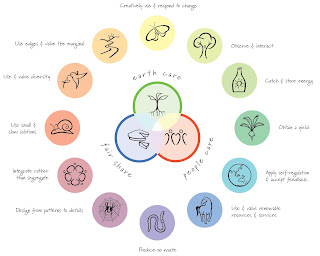In the workshop lead by Gabriel Pliska, we learned that a Food Forest is built to emulate a real forest, only we fill it with the food plants and trees that we want. There are seven layers to a food forest: 1) Canopy: large fruit trees and nut trees 2) Low tree layer: dwarf fruit trees 3) Shrub layer: currants and berries 4) Herbaceous layer: borage, lovage, comfrey 5) Rhizosphere : root vegetables 6) Ground cover: clover, strawberry, mushroom 7) Vertical layer: climbers and vines. If properly planned out, a permaculture food forest practically runs and maintains itself. Benefits include: a) habitat for local wildlife, pest control, pollination and wildlife viewing opportunities. b) Since permaculture food forests do not require chemical fertilizers or pesticides, they produce healthier foods and products. Products such as fibres, fuels, green manure, materials for crafts, food for domestic animals and can help reduce water usage in the garden. C...
